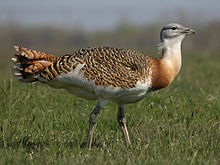Columbaves
| Columbaves Temporal range:
| |
|---|---|

| |
| Rock Pigeon (Columba livia) | |

| |
| Great Bustard (Otis tarda) | |
| Scientific classification | |
| Domain: | Eukaryota |
| Kingdom: | Animalia |
| Phylum: | Chordata |
| Class: | Aves |
| Clade: | Neoaves |
| Clade: | Columbaves Prum et al., 2015 |
| Clades | |
Columbaves is a clade that contains Columbimorphae (pigeons, mesites, and sandgrouse) and Otidimorphae (bustards, cuckoos, and turacos) discovered by genomic analysis.[1] This conflicts with the Columbea and Otidae hypotheses which Mirandornithes are the sister taxon to Columbimorphae and Cypselomorphae the sister taxon to Otidimorphae respectfully.[2] Both hypotheses however do not support the two subdivisions of Metaves and Coronoaves as previous studies had found.[3][4]
| Columbaves |
| ||||||||||||||||||||||||||||||
See also
References
- ^ Prum, R. O. et al. A comprehensive phylogeny of birds (Aves) using targeted next-generation DNA sequencing. Nature (2015). doi:10.1038/nature15697
- ^ Jarvis, E.D.; et al. (2014). "Whole-genome analyses resolve early branches in the tree of life of modern birds". Science. 346 (6215): 1320–1331. doi:10.1126/science.1253451. PMC 4405904. PMID 25504713.
- ^ Ericson, P. G.P; Anderson, C. L; Britton, T.; Elzanowski, A.; Johansson, U. S; Kallersjo, M.; Ohlson, J. I; Parsons, T. J; Zuccon, D.; Mayr, G. (2006). "Diversification of Neoaves: integration of molecular sequence data and fossils". Biology Letters. 2 (4): 543–547. doi:10.1098/rsbl.2006.0523. PMC 1834003. PMID 17148284.
- ^ Hackett, S. J.; Kimball, R. T.; Reddy, S.; et al. (2008). "A Phylogenomic Study of Birds Reveals Their Evolutionary History" (PDF). Science. 320 (5884): 1763–1768. doi:10.1126/science.1157704. PMID 18583609.




